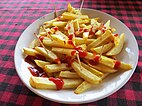Fast food is a type of mass-produced food designed for commercial resale, with a strong priority placed on speed of service. Fast food is a commercial term, limited to food sold in a restaurant or store with frozen, preheated or precooked ingredients and served in packaging for take-out or takeaway. Fast food was created as a commercial strategy to accommodate large numbers of busy commuters, travelers and wage workers. In 2018, the fast-food industry was worth an estimated $570 billion globally.[1]
The fastest form of "fast food" consists of pre-cooked meals which reduce waiting periods to mere seconds. Other fast-food outlets, primarily hamburger outlets such as McDonald's and Burger King, use mass-produced, pre-prepared ingredients (bagged buns and condiments, frozen beef patties, vegetables which are pre-washed, pre-sliced, or both; etc.) and cook the meat and french fries fresh, before assembling "to order".
Fast-food restaurants are traditionally distinguished by the drive-through. Outlets may be stands or kiosks, which may provide no shelter or seating,[2] or fast-food restaurants (also known as quick-service restaurants).[3] Franchise operations that are part of restaurant chains have standardized foodstuffs shipped to each restaurant from central locations.[4]
Many fast foods tend to be high in saturated fat, sugar, salt and calories.[5] Fast-food consumption has been linked to increased risk of cardiovascular disease, colorectal cancer, obesity, high cholesterol, insulin resistance conditions and depression.[6][7][8][9] These correlations remain strong even when controlling for confounding lifestyle variables, suggesting a strong association between fast-food consumption and increased risk of disease and early mortality.[10]
- ^ "Fast Food Industry Analysis 2018 – Cost & Trends". franchisehelp.com. Franchise Help. 2018. p. 1. Archived from the original on July 16, 2019. Retrieved July 16, 2019.
- ^ Jakle, John (1999). Fast Food: Roadside Restaurants in the Automobile Age. Johns Hopkins University Press. ISBN 978-0-8018-6920-4.; Brueggemann, Walter (1993). Texts Under Negotiation: The Bible and Postmodern Imagination. Fortress Press. ISBN 978-0-8006-2736-2.
- ^ "Quick Service Restaurants (QSR) Market Worth USD 577.71 Billion by 2028 at 3.65% CAGR – Report by Market Research Future (MRFR)". GlobeNewswire (Press release). August 18, 2021. Archived from the original on August 26, 2021. Retrieved August 26, 2021.
- ^ Talwar, Jennifer (2003). Fast Food, Fast Track: Immigrants, Big Business, and the American Dream. Westview Press. ISBN 978-0-8133-4155-2.
- ^ Hellesvig-Gaskell, Karen. "Definition of Fast Foods | LIVESTRONG.COM". LIVESTRONG.COM. Archived from the original on March 2, 2022. Retrieved May 3, 2016.
- ^ "The link between fast food and depression has been confirmed". EurekAlert!. Archived from the original on April 23, 2018. Retrieved April 22, 2018.
- ^ "Susan Cohan Colon Cancer Foundation: Prevention: Eating Well/Diet". coloncancerfoundation.org. Archived from the original on October 18, 2016. Retrieved August 16, 2016.
- ^ Publications, Harvard Health. "Red meat and colon cancer – Harvard Health". Archived from the original on December 22, 2016. Retrieved August 16, 2016.
- ^ Bao, Wei; Tobias, Deirdre K.; Olsen, Sjurdur F.; Zhang, Cuilin (December 1, 2014). "Pre-pregnancy fried food consumption and the risk of gestational diabetes mellitus: a prospective cohort study". Diabetologia. 57 (12): 2485–2491. doi:10.1007/s00125-014-3382-x. ISSN 1432-0428. PMC 4221538. PMID 25303998.
- ^ Pan, An; Malik, Vasanti; Hu, Frank B. (July 10, 2012). "Exporting Diabetes to Asia: The Impact of Western-Style Fast Food". Circulation. 126 (2): 163–165. doi:10.1161/CIRCULATIONAHA.112.115923. ISSN 0009-7322. PMC 3401093. PMID 22753305.







